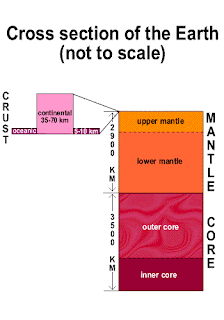What are these Layer of the Earth made of?
The outermost layer of the Earth is the crust. It is solid and comprises the continents and ocean basins. The crust has a variable thickness, being 35-70 km thick in the continents and 5-10 km thick in the ocean basins. The crust is composed mainly of alumino - silicates.
The mantle is liquid and composed mainly of ferro-magnesium silicates.This is where most of the internal heat of the Earth is located. Large convective cells in the mantle circulate heat and may drive plate tectonic processes.
The outer core is liquid and is composed mainly of a nickel-iron alloy. While the solid inner core is almost entirely composed of iron. Earth's magnetic field is believed to be controlled by the liquid outer core. The outer core is 2300 km thick and the inner core is 1200 km thick.
Why is the Core Solid???
Inner core is thought to play an important role in the generation of Earth's magnetic fields by dynamo action in the liquid outer core.The existence of the inner core also changes the dynamic motions of liquid in the outer core as it grows and may help fix the magnetic field since it is expected to be a great deal more resistant to flow than the outer core liquid.
How does the Mantle Affect Us?
Because the earth is very hot inside, a current of heat flows from the core to the crust. This is called convection current and it also takes place in the mantle. This current cools down as it comes closer to the surface of the earth. As a result, the rising of the current decreases and goes into horizontal direction along the bottom of the crust. When the current cools down more, the convection current descends again and goes to the inner earth. There the temperature increases and the current rises again. This goes on and on.
When the current comes at a weaker part of the crust, for example at a volcano, magma comes above the earth's surface. The convection current along the bottom of the crust causes the moving of the tectonic plates. This is called plate tectonics. The movement of these plates goes very slowly. The bumping of two tectonic plates causes an earthquake.
As I was doing my research, these three words, Asthenosphere, Mesosphere and Lithosphere came out very often so i decided to write the definition about it.
The asthenosphere is a zone of the earth's mantle that lies beneath the lithosphere and consists of several hundred kilometers of deformable rock. It is solid rock, but soft and flows easily (ductile).
The lithosphere is the outer part of the earth, consisting of the crust and upper mantle, approximately 100 km (62 mi.) thick.(up to 200 km thick beneath continents, thinner beneath oceanic ridges and rift valleys), very brittle, easily fractures at low temperature.The lithosphere is comprised of both crust and part of the upper mantle.
The mesosphere is about 2500 km thick, solid rock, but still capable of flowing.
Also, as I was researching, these questions came out and made me really curious. Would the Earth run out of magma? If so, then what would happen and how would it affect our lives? Another question. It may sound a little unrealistic but its worth posting. What would happen if i drilled a tunnel through the center of the earth and jump into it?
End of Post ^-^






